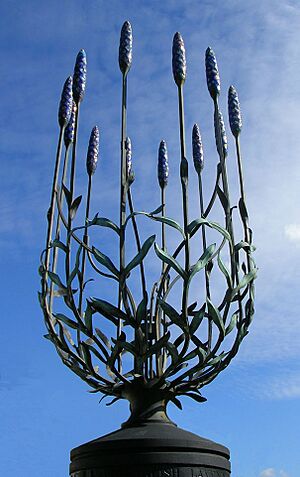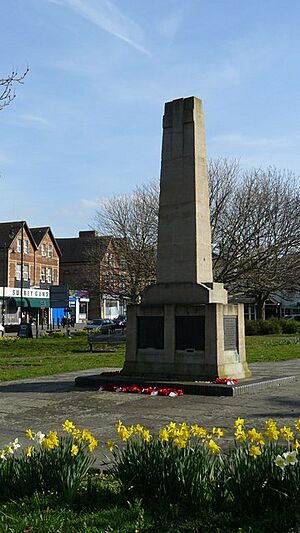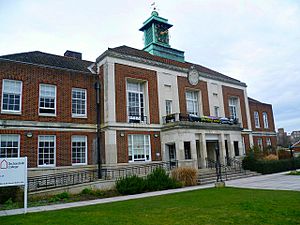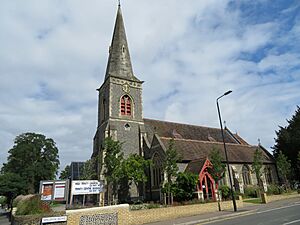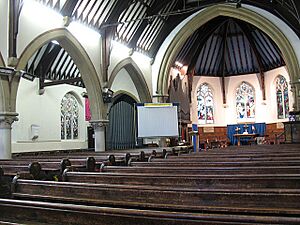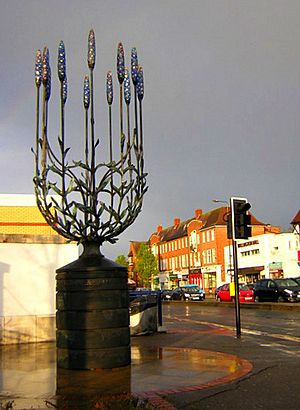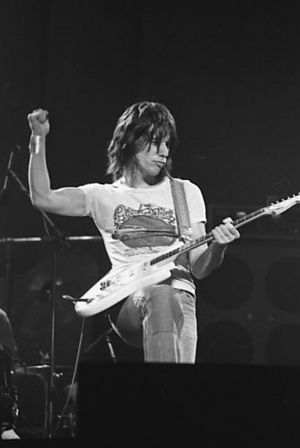Wallington, London facts for kids
Quick facts for kids Wallington |
|
|---|---|
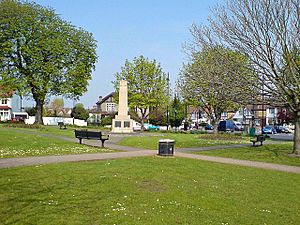 Wallington Green |
|
| Population | 20,850 (2011 Census 2 Wards) |
| OS grid reference | TQ294645 |
| London borough | |
| Ceremonial county | Greater London |
| Region | |
| Country | England |
| Sovereign state | United Kingdom |
| Post town | WALLINGTON |
| Postcode district | SM6 |
| Dialling code | 020 |
| Police | Metropolitan |
| Fire | London |
| Ambulance | London |
| EU Parliament | London |
| UK Parliament |
|
| London Assembly |
|
Wallington is a town located in South London, England. It is part of the London Borough of Sutton. The town is about 9.7 miles (15.6 km) south-west of Charing Cross, a famous spot in central London. Before 1965, Wallington was part of the county of Surrey. Today, it is a busy post town with its own postcode area.
Contents
Wallington's Past: A Look Back
The name "Wallington" comes from an old Anglo-Saxon word, "Waletone." This means "village of the Britons."
Wallington is mentioned in the Domesday Book from 1086. This was a huge survey ordered by William the Conqueror. At that time, Wallington was owned by the King himself. It had mills, fields, and meadows. The original village was a bit north of where the town centre is now. It was near Wallington Bridge over the River Wandle.
Long ago, there were two mill ponds here. The mill buildings are gone, but one pond remains. It is now The Grange boating lake. In the 1860s, a doctor named Alfred Smee created a beautiful garden by the mill pond. He even wrote a book about it called "My Garden."
How Wallington Grew
In 1847, a railway station opened south of Wallington. It was first called "Carshalton" station. This station helped the area grow a lot. In the 1860s, Nathaniel Bridges built a fancy housing estate. It had gothic revival style houses.
To serve these new homes, Bridges helped build Holy Trinity Church. Wallington became its own church area in 1867. The area around Holy Trinity Church is known as Wallington Old Town. You can still see impressive Victorian and Edwardian houses there. As the town grew south, the section of Woodcote Road near the station became the new High Street.
Wallington Methodist Church was built in 1908. It stands in Beddington Gardens in the town centre.
Wallington's Special Traditions
Since 1902, Wallington has had a special tradition: the annual Wallington May Queen crowning. This event starts with a parade through the town. Girls can join as "fairies" at age three. They then become "attendants to the May Queen" and later "crown bearers" or "banner bearers." After that, they act as "princes." Girls can become the May Queen when they are nine years old.
In 1936, the area became the Municipal Borough of Beddington and Wallington. The Wallington Town Hall and public library were built in the 1930s. The fire station on Belmont Road was also built then.
Wallington County Grammar School for boys opened in 1927. It is on London Road, near Beddington Park. Wallington High School for Girls was started by a group of nuns in 1888.
Lavender Fields and Memorials
Wallington was once famous for growing lavender. This was especially true until World War I. Huge fields of lavender grew in the Wallington, Carshalton, and Beddington areas. Growing lavender was a very successful part of farming here. The area north of the station was used for lavender.
Today, Wallington remembers its lavender history in many ways:
- A large sculpture of a lavender plant stands where Woodcote Road and Stafford Road meet. Artist Guy Portelli created it in 1999.
- The town's Christmas lights also look like lavender plants.
- A local pub, the John Jakson, is named after a lavender farmer.
- Local Scouts use lavender as their logo for the Sutton area.
Many young men from Wallington died in the First World War. In 1922, a memorial was put up on Wallington Green. It honors those who lost their lives. In 1949, names of those who died in the Second World War were added.
The memorial is a tall stone pillar with a cross on top. It has bronze plaques with the names of the fallen. It stands on blue bricks and stone. The memorial was cleaned in 2005.
The words on the memorial say:
1914 – 1918
To the glorious memory
of the men of Beddington and Wallington
who fell in the Great War.
They died that we might live.
Wallington Today
Since 2007, new shops have opened in Wallington. These include Tesco Express and Caffè Nero. They join older shops like Sainsbury's, Boots, and W.H. Smith.
New apartment buildings have also been built. Some were finished around 2010 and 2013 near the railway station. More flats in Shotfield Road were completed in 2015.
A farmers' market is held on the second Saturday of each month. You can usually find it outside the old town hall.
Sutton Community Farm is in Wallington. It is the only farm of its kind in Greater London. This farm is a not-for-profit group. It uses a 7.5-acre plot of land. This land was originally given to soldiers after the First World War.
There is a public library in the centre of Wallington. It has an outdoor area where you can get coffee and tea. The old Town Hall, which is now a college, is also in this area. It used to be a Crown Court but changed in 1999.
A small independent cinema opened in May 2014. It is at the Brook Cafe and Bar. There is also a recording studio there.
The Shotfield area also got a new, modern health centre in 2012. It replaced older health facilities.
Holy Trinity Church
Wallington's main church is Holy Trinity Church. It is on Manor Road. It was designed by Habershon and Brock and finished in 1870. It has been a Grade II listed building since 1974. This means it is an important historic building.
An older chapel, called Our Lady of the Moor, used to stand north of London Road. It was taken down around 1791. Its foundations were found in 1921. Some carved stones from its windows and arches were also found. You can still see parts of the old chapel in the walls of the Church Hall and St. Patrick's Church.
The current Holy Trinity Church was built in 1866 by Mr. Nathaniel Bridges. The church was officially opened on September 28, 1867. At that time, Wallington was part of the Diocese of Winchester. Later, it moved to the Diocese of Rochester. Now, it is part of the Anglican Diocese of Southwark.
The church was built to look like the old chapel. It has a 14th-century style. Each window has a different pattern. The church uses Bath stone with flints. The roof and floor are covered with tiles. The spire is 110 feet tall. Inside, the church is 105 feet long and 75 feet wide. It can seat 650 people.
Over the years, the church has added many beautiful stained glass windows. The windows on the south side remember people who used to worship there. The main window in the chancel remembers the first vicar, Rev. John Williams. The north window was given by families to remember those who died in World War I. The south window was a gift from the church members as a War Memorial.
In 1926, the chancel area of the church was updated. New Communion rails, a new pulpit, and a brass eagle lectern were added. A marble and alabaster baptismal font was also installed. Oak panels were put in the chancel and sanctuary. New oak doors were added at the south entrance. New choir stalls were also put in the church.
Green Spaces in Wallington
Wallington has several lovely parks. These include Mellows Park, Beddington Park, and the Grange Gardens.
Beddington Park and the Grange Gardens are in the north-east of the area. The River Wandle flows through them. Beddington Park is almost 100 acres in size. The London Borough of Sutton takes care of it. It used to be part of the deer park for Carew Manor. This was a grand country house built a long time ago.
The park has large open grassy areas with groups of trees. There are also more formal gardens near the Grange restaurant. You can find a lake and a pond there too. The main lake was originally a mill pond. The park has many paths and pretty bridges over the stream. This stream is part of the River Wandle, and the park is on the Wandle Trail. Part of the park is managed to protect wildlife.
Getting Around Wallington
Wallington has good connections for trains, buses, and bikes.
Train Services
Trains from Wallington go to Victoria and London Bridge. They also go to Epsom Downs and Epsom.
Bus Services
Many bus services run from Wallington:
- 127 to Purley, Carshalton, Mitcham, Tooting Broadway
- 151 to Carshalton, St Helier, Sutton, Cheam, Worcester Park
- 154 to Croydon, Carshalton, Sutton, Morden
- 157 to Crystal Palace, Croydon, Morden
- 407 to Caterham, Purley, Croydon, Sutton
- 410 to Crystal Palace, Norwood, Croydon, Beddington
- 463 to Coulsdon, Beddington, Mitcham
- 612 to Wallington County Grammar School
- 627 to Wallington High School for Girls
- S3 to Malden Manor, Belmont, Carshalton Beeches, Wallington North, Sutton Hospital
- S4 to Waddon Marsh, Sutton
- SL7 to Croydon, Carshalton, Sutton, Kingston, Heathrow
Bicycle Routes
National Cycle Route 20 passes through Wallington. It connects cyclists with Wandsworth on the River Thames and Brighton on the South Coast.
 |
Rose Hill | Hackbridge | Mitcham Common |  |
| Carshalton, Sutton | Beddington | |||
| Little Woodcote, Woodmansterne | Coulsdon | Purley |
Famous People from Wallington
Many notable people have connections to Wallington:
- Neil Ardley (1937–2004), a jazz pianist and composer, was born here.
- Jeff Beck (1944–2023), a famous rock guitarist, was born in Wallington. He lived on Demesne Road.
- Helen Clare (1916–2018), a singer, lived in Cranley Gardens.
- Gary Mason, a British Heavyweight Champion boxer, lived in Wallington.
- Phyllis Mudford (1906–2006), who won the Wimbledon ladies doubles in 1931.
- Mervyn Peake, a writer, lived here for five years.
- Nick Ross, a television presenter.
- Eileen Shanahan (1901–1979), an Irish poet, lived in Blenheim Gardens.
- John Debenham Taylor (1920–2016), a Secret Intelligence Service officer, was born here.
- David Walliams, a famous actor and comedian, went to primary school in Wallington.
- David Weir, a Paralympic gold medalist, lives nearby.
- Elsie Widdowson, a dietitian and nutritionist, was born in Wallington.
Sports and Fun in Wallington
Wallington has a football club called Crescent Rovers F.C.. They play at the Wallington Sports & Social Club. The town has four gold post boxes. These celebrate local resident David Weir winning four gold medals at the 2012 Summer Paralympics.
Schools in Wallington
Wallington has several schools for different age groups.
Primary Schools
- Bandon Hill Primary School
- Beddington Infants School
- Collingwood School (a fee-paying school)
- Foresters Primary School
- Highview Primary School
- Holy Trinity C of E Junior School
- St Elphege's School
- Wallington Primary Academy (formerly Amy Johnson Primary School)
Secondary Schools
- Wallington County Grammar School
- Wallington High School for Girls
- Wilson's School
These three secondary schools are all highly-rated grammar schools. Wilson's School is known as one of the best state schools in Britain. You can find more details about schools in the area in the London Borough of Sutton article.




